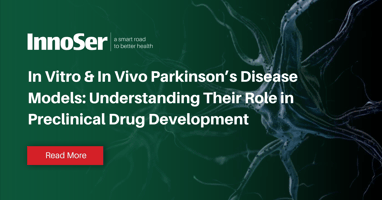Parkinson’s disease (PD) is a complex neurodegenerative disorder that affects millions of people...
Accelerating ALS Drug Development: InnoSer’s Available In Vivo Models for Preclinical Research
Amyotrophic Lateral Sclerosis (ALS) is a fatal neurodegenerative disorder lacking highly effective disease-modifying treatment or a cure. The often-heterogenous course of ALS underlines the need for modelling the different disease aspects in multiple, distinct models to enable thorough validation of novel, putative treatments.
Amyotrophic Lateral Sclerosis (ALS) pathophysiology
ALS, also known as motor neurone disease or Lou Gehrig’s disease is a severe neurodegenerative disorder that affects the motoneurons in the brain and spinal cord. This leads to progressive and rapid muscle wasting, spasticity, and eventual paralysis. Despite the highly heterogenous clinical presentation, most ALS patients die due to respiratory failure within 2-3 years of symptom onset. ALS also exists on a continuum with frontotemporal dementia (FTD).
Although most ALS cases are sporadic, genetic data reveal that a family history of ALS is present in 5–10% of affected individuals, usually with an autosomal dominant inheritance pattern. The four genes that account for most of the familial ALS cases are C9orf72 (40%), SOD1 (20%), FUS (1–5%), and TARDBP (1–5%). In addition, virtually all ALS cases have cytoplasmic inclusions of aggregated nuclear protein TDP-43. The identification of several pathophysiological mechanisms leading to both familial and sporadic cases of ALS enables its recapitulation in in vivo models allowing preclinical testing of promising ALS-targeted therapies.
InnoSer, a leading provider of in vivo contract research services, offers several mouse models for ALS research. In combination with sensitive, standardized behavioral tests. The mouse models provide a translationally relevant platform for testing novel ALS-targeted therapies. In this article, we provide an overview of currently available mouse models and their applicability.
Modelling Early-stage ALS: SOD1 mutations
SOD1 plays a crucial role in free radical scavenging and regulates the expression of genes involved in oxidative stress response. Inherited mutations in the SOD1 gene are thought to result in intracellular formation and accumulation of toxic protein aggregates. In turn, this results in increased oxidative stress which ultimately manifests as a decline in motor function.
Mice overexpressing the human protein with SOD1 mutation present significant SOD1 aggregation, oxidative stress, and motoneuron loss. Accordingly, we detect significant motor problems in transgenic SOD1 mice in motor function tests (such as grip strength test and rotarod) but also in spontaneous behavior (automated-home cages, PhenoTyper™) in comparison to their WT littermates. The behavioral deficits in these models are already detectable at young ages and show progressive development, providing a large time frame for testing targeted novel therapeutics. The SOD1G93A and SOD1G37R models are the most used transgenic SOD1 models for ALS research.
Modelling ALS pathophysiology: TDP-43 formation and spreading
TDP-43 proteinopathy is a pathological hallmark in almost all patients with ALS, as well as FTD and limbic-predominant age-related TDP-43 encephalopathy (LATE). Pathological accumulation of misfolded TDP-43 protein aggregates has been closely associated to the neurodegenerative phenotype observed in ALS patients.
TDP43 Transgenic Models:
TDP-43 transgenic models overexpress mutant forms of human TDP-43, leading to motoneuron degeneration and paralysis. TDP-43 mouse models used at InnoSer recapitulate the TDP-43 pathology and downstream functional impairments found in ALS and FTD.
Transgenic TDP-43 models are best suited for testing novel therapies that target the TDP-43 pathology-associated dysfunction in RNA processing and protein homeostasis. The TDP-43WT, TDP-43Q331K, and TDP-43A315T models are the most commonly used transgenic TDP-43 models for ALS research.
TDP-43 Seeding Models:
TDP-43 seeding models involve the injection of patient-derived TDP-43 aggregates into the brain of mice. Injection of brain extracts from these diseases in the brain of mice closely mimics the structural features of the TDP-43 aggregates found in patients and allows studying the spread TDP-43 aggregates as a therapeutic readout. InnoSer’s neurology study team has extensive experience with seeding-based mouse models, both with recombinant and patient-derived seeds.
Choosing the most suitable model
InnoSer’s expert neurology team is readily equipped to consult with you to determine the best model in conjunction with readout customization to meet your specific needs and goals. Consulting with our team will allow you to carry out tailored studies while collecting the most relevant data. We also advise you on the most optimal model selection, taking in your budget and study timelines.


